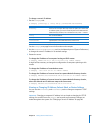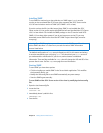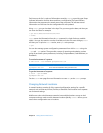
74 Chapter 6 Setting Network Preferences
To start SNMP on Mac OS X 10.4 client computers by modifying the hostconfig file:
Mac OS X 10.4 client systems already have the SNMPSERVER:=-NO- line in their
hostconfig file by default.
1 Open the /etc/hostconfig file.
2 Locate the line:
SNMPSERVER=-NO-
3 Change NO to YES.
4 Save the file.
Note: Systems running Mac OS X Server version 10.3 or earlier will need to have the
line added.
Changing the SNMPSERVER line in the hostconfig file, causes snmpd to be executed
during system startup, with no options, as dictated by the /System/Library/
StartupItems/SNMP/SNMP file. For further instruction on editing configuration files,
including important precautionary statements, see technical document 106619, “Mac
OS X Server: How to Edit Configuration Files”.
To start the snmp agent manually:
$ /usr/sbin/snmpd
Configuring SNMP
The configuration (conf) file for snmpd is typically in the /usr/share/snmp/ folder, and is
named snmpd.conf or snmpd.local.conf. If you have an environment variable
SNMPCONF, snmpd will read any files named snmpd.conf and snmpd.local.conf in these
folders. The SNMP agent can be started with a -c flag to indicate other conf files. See
the snmpd man page for more information about which conf files can be used.
Configuration files can be created and installed more easily using the included script
/usr/bin/snmpconf. As root, use this script with the -i flag to install the file in the
/usr/share/snmp/ folder. Otherwise, the default location for the file to be written is the
user's home directory (~/). Only root has write permission for /usr/share/snmp/.
Because snmpd reads its conf files at startup, changes to the conf files require that the
process be stopped and restarted. To do this, you must identify the process id.
To identify the process id:
$ ps aux |grep snmpd
To stop snmpd :
$ kill <pid>
Once snmpd is stopped, you can customize the snmpd.conf file as needed.


















